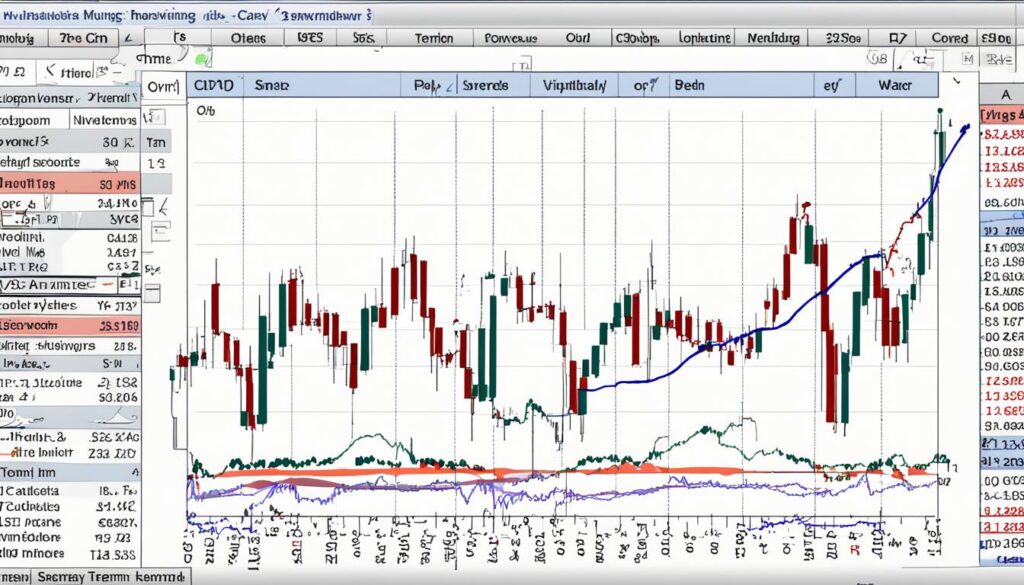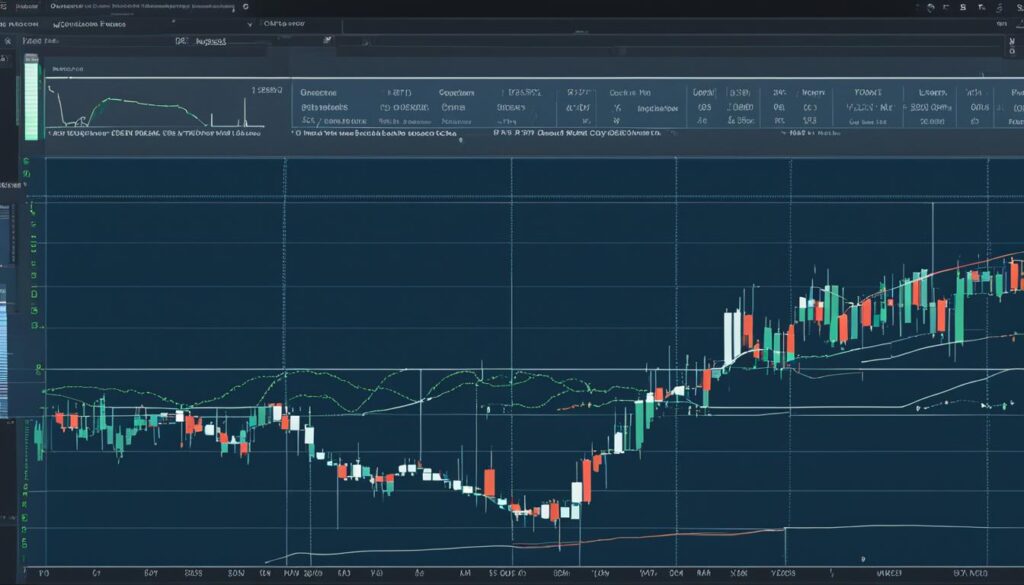The key to successful day trading lies in utilizing the right indicators to maximize your trading strategy. By analyzing market data, these indicators provide insights into market trends, volatility, and potential entry and exit points for trades.
As a seasoned day trader, I understand the importance of incorporating the best indicators into your trading routine. They can make all the difference in identifying profitable opportunities and minimizing risk.
In this article, I will share some of the top indicators that can significantly enhance your day trading approach. Whether you are a beginner or an experienced trader, these indicators can help you make informed decisions and increase your chances of success.
Before we dive into the specifics, it’s important to note that no single indicator guarantees success in day trading. It’s a combination of factors, including proper risk management and market analysis, that ultimately contribute to profitable trades. However, the indicators discussed here have proved to be highly effective for many traders.
Key Takeaways:
- Utilizing the right indicators is crucial for successful day trading.
- Indicators provide insights into market trends, volatility, and potential entry and exit points.
- No single indicator guarantees success; it’s a combination of factors that contribute to profitable trades.
- Proper risk management and market analysis are essential for day trading success.
- The indicators discussed in this article have proven to be highly effective for many traders.
Moving Averages: A Key Indicator for Day Traders
Moving averages are an essential tool for day traders in the world of day trading. They play a crucial role in identifying trends in the market, providing traders with valuable insights into the market’s direction. By calculating the average price of an asset over a specific period, moving averages smooth out price fluctuations, allowing traders to focus on the underlying trend.
There are different types of moving averages that day traders utilize, including simple moving averages (SMA) and exponential moving averages (EMA). Simple moving averages give equal weightage to all prices within the selected time period, providing a more balanced view of the market. On the other hand, exponential moving averages emphasize recent prices, making them more sensitive to short-term price movements.
Day traders often use moving averages to identify key levels of support and resistance, as well as to determine potential entry and exit points for trades. When the price crosses above a moving average, it may signal a bullish trend, while a crossing below may indicate a bearish trend. Traders also observe the relationship between different moving averages, such as the crossing of a shorter-term moving average above or below a longer-term moving average, to confirm trend reversals or continuations.
Here’s an example to illustrate the use of moving averages in identifying trends:
“As an experienced day trader, I rely heavily on moving averages to identify trends and make informed trading decisions. Recently, I noticed that the 50-day moving average of ABC stock crossed above the 200-day moving average. This crossover indicated a potential bullish trend, prompting me to seek long trading opportunities. Sure enough, the stock’s price continued to rise, validating the accuracy of the moving average signal.”
It’s important to note that moving averages work best in trending markets, and may produce false signals or generate incorrect indications in sideways or choppy markets. Hence, it’s crucial for day traders to combine moving averages with other indicators and tools to enhance their trading strategy.
Summary:
Moving averages are indispensable indicators for day traders aiming to identify trends in the market. By calculating the average price over a specific period, these indicators smooth out price fluctuations and provide traders with a clearer understanding of the market’s direction. Whether using simple moving averages or exponential moving averages, day traders can utilize these tools to identify potential entry and exit points, as well as key levels of support and resistance.

The Relative Strength Index (RSI): A Powerful Tool for Day Traders
When it comes to day trading, having the right tools at your disposal is crucial for making informed decisions. One such tool that has gained significant popularity among day traders is the Relative Strength Index (RSI). This powerful momentum oscillator helps traders identify overbought and oversold conditions in the market, providing valuable insights for executing profitable trades.
Developed by J. Welles Wilder, the RSI compares the magnitude of recent price gains to recent price losses, generating a value between 0 and 100. This value is used to determine the strength and speed of price movements, indicating whether an asset is overbought or oversold.
When the RSI value exceeds 70, it signifies that the asset is overbought, suggesting that a price correction or reversal may occur. Conversely, when the RSI value falls below 30, it indicates that the asset is oversold, implying a potential upward price movement. By paying attention to these overbought and oversold signals, day traders can identify opportune moments to enter or exit trades, enhancing their profit potential.
Day traders often use the RSI in conjunction with other technical indicators to confirm trading signals and increase the accuracy of their analysis. For example, combining the RSI with moving averages can provide a more comprehensive understanding of market trends and potential trade opportunities.
By incorporating the RSI into their day trading strategies, traders can gain a competitive edge and make more informed decisions. However, it is important to remember that no single indicator guarantees success in day trading. It is crucial to consider other factors, such as market conditions and risk management, to maximize profitability and minimize potential losses.
RSI Calculation Formula:

| Calculation Step | Formula |
|---|---|
| Average Gain | (Sum of gains over a specific period) / (Number of periods) |
| Average Loss | (Sum of losses over a specific period) / (Number of periods) |
| Relative Strength (RS) | Average Gain / Average Loss |
| RSI | 100 – (100 / (1 + RS)) |
By following the RSI calculation formula, traders can obtain the RSI value for a given asset and use it to make data-driven trading decisions. Remember to adjust the period length and use proper risk management strategies to optimize the effectiveness of the RSI in your day trading endeavors.
Conclusion
Successful day trading hinges on the effective use of day trading indicators to maximize your trading strategy. These indicators provide invaluable insights into market trends, volatility, and optimal entry and exit points. By incorporating the best indicators into your trading approach, you can increase your chances of success in this challenging endeavor.
Understanding the market is key to day trading. It requires extensive knowledge of price movements, market trends, and economic factors that can impact asset prices. It is also crucial to implement proper risk management techniques to protect your capital and minimize potential losses.
However, without the right day trading indicators, even the most experienced traders may struggle to make informed decisions in the fast-paced world of day trading. These indicators can help you identify profitable trading opportunities, assess market conditions, and improve the accuracy of your trading strategies.
FAQ
What is day trading?
Day trading is a form of trading where traders buy and sell financial assets within the same trading day, aiming to profit from intraday price movements.
Why are indicators important in day trading?
Indicators are crucial in day trading as they provide insights into market trends, volatility, and potential entry and exit points for trades, helping traders make informed decisions.
What are moving averages?
Moving averages are indicators used by day traders to identify trends in the market. They calculate the average price of an asset over a specific period, smoothing out price fluctuations.
What types of moving averages are commonly used in day trading?
Commonly used moving averages in day trading include simple moving averages (SMA) and exponential moving averages (EMA).
How does the Relative Strength Index (RSI) help day traders?
The Relative Strength Index (RSI) is a popular momentum oscillator that helps day traders identify overbought or oversold conditions in the market by comparing recent price gains and losses.
What is the range of the Relative Strength Index (RSI) values?
The Relative Strength Index (RSI) values range between 0 and 100, with values below 30 indicating oversold conditions and values above 70 indicating overbought conditions.
How can I increase my chances of success in day trading?
To increase your chances of success in day trading, it is important to have a solid understanding of the market, practice proper risk management, and incorporate the best indicators into your trading strategy.
Source Links
Disclaimer
All information on this website is of a general nature. The information is not adapted to conditions that are specific to your person or entity. The information provided can not be considered as personal, professional or legal advice or investment advice to the user.
This website and all information is intended for educational purposes only and does not give financial advice. Signal Mastermind Signals is not a service to provide legal and financial advice; any information provided here is only the personal opinion of the author (not advice or financial advice in any sense, and in the sense of any act, ordinance or law of any country) and must not be used for financial activities. Signal Mastermind Signals does not offer, operate or provide financial, brokerage, commercial or investment services and is not a financial advisor. Rather, Signal Mastermind Signals is an educational site and a platform for exchanging Forex information. Whenever information is disclosed, whether express or implied, about profit or revenue, it is not a guarantee. No method or trading system ensures that it will generate a profit, so always remember that trade can lead to a loss. Trading responsibility, whether resulting in profits or losses, is yours and you must agree not to hold Signal Mastermind Signals or other information providers that are responsible in any way whatsoever. The use of the system means that the user accepts Disclaimer and Terms of Use.
Signal Mastermind Signals is not represented as a registered investment consultant or brokerage dealer nor offers to buy or sell any of the financial instruments mentioned in the service offered.
While Signal Mastermind Signals believes that the content provided is accurate, there are no explicit or implied warranties of accuracy. The information provided is believed to be reliable; Signal Mastermind Signals does not guarantee the accuracy or completeness of the information provided. Third parties refer to Signal Mastermind Signals to provide technology and information if a third party fails, and then there is a risk that the information may be delayed or not delivered at all.
All information and comments contained on this website, including but not limited to, opinions, analyzes, news, prices, research, and general, do not constitute investment advice or an invitation to buy or sell any type of instrument. Signal Mastermind Signals assumes no responsibility for any loss or damage that may result, directly or indirectly, from the use or dependence on such information.
All information contained on this web site is a personal opinion or belief of the author. None of these data is a recommendation or financial advice in any sense, also within the meaning of any commercial act or law. Writers, publishers and affiliates of Signal Mastermind Signals are not responsible for your trading in any way.
The information and opinions contained in the site are provided for information only and for educational reasons, should never be considered as direct or indirect advice to open a trading account and / or invest money in Forex trading with any Forex company . Signal Mastermind Signals assumes no responsibility for any decisions taken by the user to create a merchant account with any of the brokers listed on this website. Anyone who decides to set up a trading account or use the services, free of charge or paid, to any of the Broker companies mentioned on this website, bears full responsibility for their actions.
Any institution that offers a service and is listed on this website, including forex brokers, financial companies and other institutions, is present only for informational purposes. All ratings, ratings, banners, reviews, or other information found for any of the above-mentioned institutions are provided in a strictly objective manner and according to the best possible reflection of the materials on the official website of the company.
Forex/CFD trading is potentially high risk and may not be suitable for all investors. The high level of leverage can work both for and against traders. Before each Forex/CFD investment, you should carefully consider your goals, past experience and risk level. The opinions and data contained on this site should not be considered as suggestions or advice for the sale or purchase of currency or other instruments. Past results do not show or guarantee future results.
Neither Signal Mastermind Signals nor its affiliates ensure the accuracy of the content provided on this Site. You explicitly agree that viewing, visiting or using this website is at your own risk.


